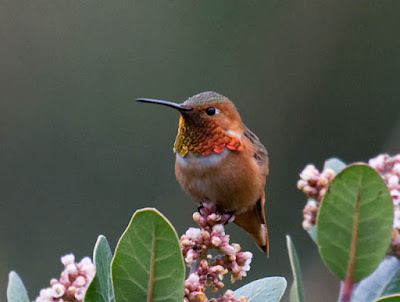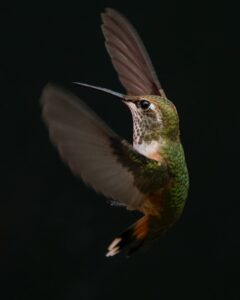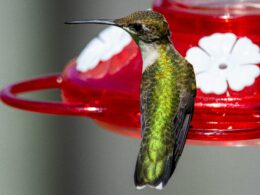Last Updated on January 10, 2024 by Greg Gillson
Once you have selected your hummingbird feeder you need to decide on the best placement. Where is the best place to put hummingbird feeders? Should you hang them in the sun or shade?
Hummingbird feeders should be placed to receive morning sun and afternoon shade.
Hummingbird nectar can go bad more quickly if the feeder is hanging in the sun all day. However, there are also good reasons for placing your hummingbird feeder so that it does get some sun during the day. And sun isn’t the only consideration for proper hummingbird feeder placement.
An open line of sight for hummingbirds to find the feeder
Whether you put the hummingbird feeder in sun or shade it should be placed so that hummingbirds passing through can see it easily. Especially when birds first arrive in spring you want to attract their attention. So having your feeder highly visible from multiple angles is important.
You may also hang red decorations near the feeders to grab the attention of hummingbirds. Hanging baskets of red flowers will also work. Fuchsias and geraniums have red blooms in early spring that will quickly grab the attention of hummingbirds and add an attractive landscaping element to your entry or porch.
If your neighbors have active hummingbird feeders, you may want to place your new feeder in line of sight of your neighbor’s feeder. That way, if they show up for hummingbird food at your neighbor’s feeder, they will see yours also. Then they will quickly come to inspect it!
Once you have several hummingbirds regularly visiting your feeder you can move it if you think it is getting too much sun. How do you tell if your feeder is getting too much sun? Read on!
 |
|
Allen’s Hummingbird
Photo by Greg Gillson
|
Beautiful morning sunlight for observing hummingbirds
There’s nothing like the gem-like brilliance of iridescent hummingbird plumage in the golden glow of early morning sunshine. No doubt you’ll want to have your hummingbird feeders set up to catch the first rays of sun. After the day starts to warm, though, you may want to have your feeder enter the shade.
Where to hang hummingbird feeder? Of course, you have to be able to see the feeder in order to enjoy it fully. The best place to hang your hummingbird feeder is where you will see it from inside your home. Hummingbirds visit your feeder first thing in the day. As soon as the day begins at sunrise hummingbirds start coming to your feeder. So, what window will you be looking out first thing in the morning? This will be your “morning feeder.”
Hummingbirds also increase their visits to feeder in the evening, frequently well after sunset. They load up on calories to get through the cooler nights. It may be that you will want to set up a second hummingbird feeder to watch the hummingbirds in the afternoon and evening. There’s no reason not to have more than one feeder!
Remember, too, that your most dominant hummingbird will choose an exposed perch in view of the hummingbird feeder. From this taller vantage point the dominant bird (often a male) will chase away any other hummingbirds. But also, this exposed perch will also likely be in the sun showing the brilliant plumage to great advantage.
Is it ok to put hummingbird feeders in the sun?
You might think that nectar in a glass hummingbird feeder might get very hot in the summer sun all day. Could such hot liquids burn the tongue of hummingbirds? No one would want to do that! Should hummingbird feeders be placed in the shade for this reason?
Evidently not. According to the information I could find (source), liquids in a hummingbird feeder only get a maximum of about 10 degrees Fahrenheit warmer than surrounding air temperature. That wouldn’t be hot enough to burn skin (or tongue) even on the hottest summer day. That’s very good to know.
Hummingbird feeders placed in direct sun will not burn the hummingbirds coming for a drink. But there is another reason for placing hummingbird feeders in the shade.

Keep hummingbird feeders in the shade to keep the nectar from spoiling quickly
The most important reason to keep the hummingbird feeder in the shade is to make the hummingbird food last longer without spoiling. That sugar water in the sun can quickly grow colonies of bacteria and mold. Bacteria often displays as cloudy hummingbird nectar. Mold is dark patches growing on the inside surface of the hummingbird feeders.
If your hummingbird food is cloudy, or if you see dark patches growing on the inside of the feeder, take your feeder down immediately. Discard the remaining liquid. Clean, wash, scrub, and rinse the feeder. Add fresh hummingbird nectar.
Even if you do not notice signs of bacteria or mold it is a good idea to change your nectar every 3 days in hot weather and at least once a week in cool weather. If you notice that hummingbirds aren’t feeding as often, appearing perhaps to have abandoned a feeder that still has liquid in it, it may be a good idea to clean the feeder and change the nectar.
Remember to always thoroughly wash your feeder between fillings. Do not “top off” a feeder. Always wash the feeder before adding more nectar. It may be a bit of work, but it is worth it to keep your hummingbirds healthy and coming back.
Obviously, the more sun your feeders receive the more quickly the nectar will go bad. Feeders in the full summer sun all day may need changed every other day to keep from spoiling. Feeders in the shade will last longer before spoiling.
I always recommend only filling feeders with as much nectar as the hummingbirds drink within the time period that the feeders need cleaned. Thus, feeders in full sun should only have enough nectar that hummingbirds drink it all in 2 days. That way you never have excess nectar spoiling in the sun. Hummingbirds will quickly return to an empty feeder if you clean and refill it with a day or two.

How to shade your hummingbird feeder
Perhaps the easiest way to shade your hummingbird feeder from hot mid-day sun is to hang your feeder under your eaves. This way it will likely have some morning or evening sun, but it will be protected in shade during the heat of the day.
You may hang the feeder from a tree branch or heavy bush to provide shade throughout the day. One possible disadvantage, though, is that hummingbird feeders placed in a plant may be more prone to attracting ants to the feeder.
You can shade your hummingbird feeder with a dome. There are many shade guards for hummingbird feeders available. Here’s one that is 14 inches wide.
You might even try making your own hummingbird feeder shade as a do-it-yourself project!
Protecting the hummingbird feeder from the wind
Hummingbird feeders tend to swing in the wind. The food can quickly spill out in windy conditions. Besides offering an empty feeder to the hummingbirds, the spilled sugar fluid will likely attract ants or other pests.
A location with shade may also offer some protection from the wind, whether it is under the eaves, next to a wall, or under a tree. Hummingbirds don’t mind if the feeder is gently swaying in the soft breeze. But they will likely avoid a wildly swinging and twisting feeder in strong winds. So a shaded location may provide this added calming benefit.
A place for hummingbirds to hide
A feeder placed out in the open may leave hummingbirds feeling exposed and vulnerable. They may desire a substantial bush in which to hide or rest within 5 feet or so of the feeder. If protection is farther away the birds may leave the yard completely every time they are startled just a bit. If they have a nearby place of safety they are likely to spend more time in the yard.
A dominant hummingbird will also try to chase away all interlopers. A dense bush nearby for the less dominant birds to hide in may allow them to wait their turn when the dominant bird is chasing someone else!
Do you have a large shrub or small bushy tree that can provide both shade during the hottest part of the day and protection too? That’s be the best place to put hummingbird feeders.
Hummingbird feeders should be off the ground at least 5 feet, though. This will keep them above the pouncing height of most cats. Cats may lie in wait on the ground under a very dense bush to try to get to birds at your feeder. This includes hummingbirds.

Wrapping Up
We discussed having an open line of sight so hummingbirds can find your feeder as they fly by–especially in spring when the birds first arrive.
We talked about where to set up your feeders to view them from your windows that you’ll be looking out in the morning.
It is okay to have hummingbird feeders in the sun all day, but the nectar will last longer without spoiling in the shade.
Having some protection from the wind will keep nectar from spilling out.
Placing feeders near a bush or small tree may provide a hiding place for the hummingbirds and make them feel more secure in your yard, as well as provide some additional shade.
I have personally been enjoying the easy-to-clean More Birds brand hummingbird feeder. There are several sizes.
Frequently Asked Questions
Should hummingbird feeders be hung high or low?
The ideal height for hummingbird feeders depends on several factors, but generally speaking, somewhere between 4 and 6 feet above the ground is a good sweet spot. Here’s why:
Balancing safety and accessibility:
- Too high: Placing feeders above 6 feet might make them difficult for hummingbirds to spot and access, especially younger or weaker individuals.
- Too low: Hanging them too close to the ground (below 4 feet) exposes them to potential threats like pets, predators on the ground, and splashes from lawn sprinklers.
Considering your surroundings:
- Obstacles: Avoid hanging feeders near branches, walls, or other structures that might obstruct flight paths or create collisions.
- Visibility: Place them in open areas with good sunlight, where hummingbirds can easily see the brightly colored feeders.
- Competition: Hanging multiple feeders at different heights can discourage larger or dominant birds from monopolizing a single source and allow smaller hummingbirds to access food peacefully.
How do you attract hummingbirds to a new feeder?
Hummingbirds, those iridescent jewels of the feathered world, might take a little convincing to visit your new feeder. But fear not, for with a few enticing tactics, you can transform your backyard into a hummingbird hangout! Here are some strategies to attract these winged wonders:
Make it visible:
- Hang your feeder in a sunny, open area, preferably near trees or shrubs where hummingbirds like to perch. Avoid placing it too close to windows or reflective surfaces that might confuse them.
- Use a brightly colored feeder, especially red, as this naturally attracts hummingbirds. You can even add red ribbons or flags near the feeder to further pique their interest.
Sweeten the deal:
- Offer fresh, homemade nectar made with 1 part white sugar to 4 parts water. Boil the water to dissolve the sugar and remove any impurities. Avoid artificial sweeteners or red dyes, which can harm hummingbirds.
- Change the nectar every 2-3 days, especially during hot weather, to prevent fermentation and bacteria growth. You can keep the remaining nectar in the refrigerator until it’s time for a refill.
- Consider adding multiple feeders at different heights and locations to accommodate several hummingbirds and prevent territorial squabbles.
Create a welcoming habitat:
- Plant native flowers that attract hummingbirds, such as columbine, honeysuckle, bee balm, and trumpet vine. These will provide additional food sources and encourage hummingbirds to linger in your yard.
- Offer a water source, such as a birdbath or drip fountain. Hummingbirds need water just like any other bird, and the splashing sound can also attract them.
- Minimize noise and distractions. Hummingbirds are shy creatures, so avoid placing feeders near loud speakers, busy traffic areas, or flapping laundry.
Why won’t the hummingbirds drink from my feeder?
Hummingbird feeders can sometimes hold the secret to a charming backyard ballet of vibrant wings and cheerful chirps, but seeing them sit untouched can be quite the discouragement. Don’t fret! There are several reasons why hummingbirds might be ignoring your feeder, and with a little detective work, you can turn the tide and attract these feathered jewels. Here are some possible culprits and remedies:
Feeder Issues:
- Location: Is the feeder in a sunny, open area where hummingbirds can easily spot it? Avoid hiding it amongst foliage or placing it near reflective surfaces that might confuse them.
- Cleanliness: Hummingbirds are hygienic creatures and won’t touch a dirty feeder. Clean it regularly with soapy water and disinfect it occasionally with a diluted bleach solution.
- Nectar: Is the nectar fresh? Change it every 2-3 days, especially in hot weather, to prevent fermentation and bacteria growth. Use a 1:4 ratio of white sugar to water for the nectar recipe.
- Accessibility: Are the feeder ports easy for hummingbirds to reach? Avoid narrow or clogged openings that might discourage them. Consider different feeder styles to cater to various species preferences.
Competition and Threats:
- Dominant birds: Larger birds like squirrels or jays might be monopolizing the feeder. Try adding squirrel baffles or using feeders designed to deter them.
- Predators: Cats, hawks, or other predators lurking nearby can scare away hummingbirds. Place the feeder in a safe location with nearby cover for quick escapes.
- Territorial Hummingbirds: Sometimes, a territorial hummingbird might keep others away. Consider adding multiple feeders at different heights to offer more feeding options.
________________________________________________________________________________________________
Related Articles:
When to put out and take down your feeders in each state!
How do you stop hummingbirds from fighting over feeders?
Why aren’t hummingbirds coming to your feeder?











This is a very interesting and informative article about Hummingbird Feeders. Thank you very much!
Thank you for your kind words!
Does having a feeder within a foot of a window too close? I'm not seeing any birds with my new hummingbird feeder location.
Thanks for your question.
Hummingbirds do come to window feeders, so yours is not too close. Perhaps temporarily add a second feeder out farther where birds passing by can see it.
I'm getting bees!
Oh no!
Please read my article covering this topic: "How do I get rid of birds at my hummingbird feeder?"
https://whatbirdsareinmybackyard.com/2020/06/how-do-i-get-rid-of-bees-at-my-hummingbird-feeder.html
This is all so very helpful! I haven't seen my hummingbirds come by in a few days and there is still liquid in my feeders. I'm going to clean them out, put out fresh liquid and hope for the best. Thank you!
Hope there are still some around, Tina.
Thanks for commenting!
I completely disagree with the oil or Vaseline. If that gets on the hummingbirds wings they are done for. So please research more before doing anything like what they are suggesting. I use homemade anything most I keep them clean and hummingbirds will drink out of them. So please no oil or Vaseline. I've been feeding hummingbirds for over 35 years. I want to keep them around. They yell at me when food is gone. I have 12 single feeders I increase as summer goes on. It's a great choir I never complain about.
I completely agree.
The recommendation to use petroleum jelly in the Perky-Pet video is not a good idea.
The rest of the video is so useful… too bad.
I enjoyed your entries. I have a question about keeping the feeder filled. Is it okay to only fill it once a week even though it may empty before the week is up?
I followed the instructions and hung the feeder about 15 minutes ago and looked out a minute later and a hummingbird was feeding! Yay! Thank you.
Yes, once a feeder is established, you can let it go empty without losing birds in summer/fall. However, you may get more hummingbirds by keeping it full.
Letting it go dry can also kill the mold or bacteria. But, still, clean it well when refilling.
That's wonderful, Valerie!
Will an owl statue with rotating head keep hummingbirds away from a feeder? It’s not working on the mourning doves.
Would it fool you?
Wild animals quickly learn to tell real danger from fake. Scarecrows (and "scareowls") don't tend to work.
How close to a regular bird feeder, can I put my hummingbird feeder? I have heard that wild birds can be aggressive at feeders and can harm a hummingbird. Is this true?
Some birds such as jays may be able to catch a hummingbird, but the little guys are pretty fast and aggressive themselves, even attacking red-tailed hawks that get too close.
Nevertheless, I'd separate hummingbird feeders from other feeders, if possible. 15 feet away should be fine.